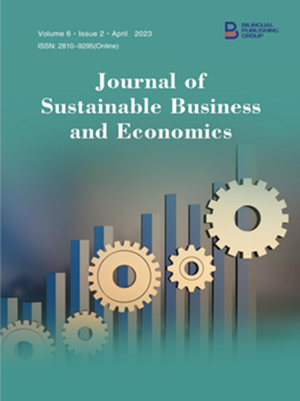-
301
-
195
-
178
-
173
-
145
Fiscal Policy and Inflation in Nigeria
DOI:
https://doi.org/10.30564/jsbe.v6i2.5739Abstract
This paper empirically examined the impact of fiscal policy on inflation in Nigeria. Time series data on inflation, government revenue, government expenditure, and gross domestic product were sourced from the Central Bank of Nigeria (CBN). The aforementioned secondary data cover the period from 1981 to 2021. The Augmented Dickey Fuller (ADF) unit root test and Johansen co-integration test were used to testing for data stationarity and the existence or otherwise of co-integrating equations respectively. Thereafter, data were analyzed using Ordinary Least Square and Parsimonious Error Correction techniques. Findings from the study show that government expenditure and revenue both have a positive relationship with the rate of inflation, though the latter is not statistically significant. Also, there is a positive but insignificant relationship between inflation and gross domestic product. In line with the above findings, we, therefore, recommend that the Nigerian government at all levels (local, state, and federal) should be tactful in the use of fiscal policy tools to avoid triggering inflationary pressure and its negative multiplier effects on the welfare of its citizenry.
Keywords:
Inflation; Fiscal policy; Gross domestic product; Government expenditure; Government revenueReferences
[1] Frederick, M.S., Apostolos, S., 2005. The economics of money, banking, and financial markets. Pearson: London.
[2] Fischer, S., 1993. The role of macroeconomic factors in growth. Journal of Monetary Economics. 32(3), 485-512.
[3] Ajie, H.A., Jonah, A., Denis, B.E., 2007. Issues in macroeconomic. Pearl Publishers: Port Harcourt.
[4] Onwubuariri, S.E., Oladeji, S.I., Bank-Ola, R.F., 2021. Inflation and economic growth in Nigeria: An ARDL bound testing approach. Sapientia Foundation Journal of Education, Sciences and Gender Studies. 3(1).
[5] Bredino, S., Fiderikumo, P., & Henry, A., 2022. Public Expenditure and Economic Growth in Nigeria: An Empirical Analysis. International Journal of Advanced Academic Research. 8(11), 180-187.
[6] Alexander, S. W.,2022. Fiscal Policy and Inflation [Internet]. American Institute for Economic Research. Available from: https://www.aier.org/article/fiscal-policy-and-inflation/
[7] Jhingan, M.L., 2004. Monetary economics. Vrinda Publications Ltd.: Delhi.
[8] Gbanador, C. A., 2007. Modern Macroeconomics. Pearl Publisher: Port Harcourt.
[9] Laidler, D.E., Stadler, G.W., 1998. Monetary explanations of the Weimar Republic’s hyperinflation: Some neglected contributions in contemporary German literature. Journal of Money, Credit and Banking. 3(4), 816-831.
[10] Keynes, J., 1936. General theory of employment, interest and money. Harcourt: London.
[11] Ryan, B., Valerie, B., Aaron, M., et al., 2022. Fiscal Deficits and Inflation Risks: The Role of Fiscal and Monetary Regimes [Internet]. Bank for International Settlements. No. 1028. Available from: https://www.suerf.org/suer-policy-brief/55051/fiscal-deficits-and-inflation-risks-the-role-of-fiscal-and-monetary-policy-regimes
[12] Babalola, A.I., 2015. Fiscal policy and economic development in Nigeria. Journal of Economics and Sustainable Development. 6(7), 150-159.
[13] Agu, S.U., Okwo, I.M., Ugwunta, O.D., et al., 2015. Fiscal policy and economic growth in Nigeria: Emphasis on various components of public expenditure. Sage Open. 5(4). DOI: https://doi.org/10.1177/2158244015610171
[14] Nye, T.E.,2013. Macroeconomics. Dominus Printing Co: Port Harccourt.
[15] Bredino, S., Dikeogu, C., Fiderikumo, P., 2022. Fiscal policy and unemployment in Nigeria: A structural analysis. African Journal of Business and Economic Development. 2(12), 117-126.
[16] Peter, T., 2014. Fiscal policy and the inflation target. International Journal of Central Banking. 10(2), 63-96.
[17] Leeper, E.M., 1991. Equilibria under ‘active’ and ‘passive’ monetary and fiscal policies. Journal of monetary Economics. 27(1), 129-147.
[18] Bredino, S., Fiderikumo, P., Adedoyin, A., 2022. Fiscal policy implementation in Nigeria: Issues and challenges. International Journal of Economics and Management Studies. 9(5), 32-36.
[19] Egbulonu, K.G., Amadi, K.W., 2016. Impact of fiscal policy on inflation in Nigerian economy. International Journal of Innovative Development & Policy Studies. 4(3), 53-60.
[20] Otto, G., Ukpere, W.I., 2015. The impact of fiscal policy on inflation in Nigeria. Risk Governance & Control: Financial Markets & Institutions. 5(1), 123-132.
[21] Surjaningsih, N., Utari, G. D., Trisnanto, B., 2012. The Impact of Fiscal Policy on the Output and Inflation. Buletin Ekonomi Moneter dan Perbankan, 14(4), 367-396.
[22] Philip, R. C., 2004. Fiscal Policy and Inflation Volatility [Internet]. Available from: https://ssrn.com/abstract=515081
[23] Data & Statistics [Internet]. Central Bank of Nigeria; 2021. Available from: https://www.cbn.gov.ng/rates/
[24] Nwankwo, O.C., 2013. A practical guide to research writing for students of research enterprise. University of Port Harcourt Press: Port Harcourt.
[25] Dickey, D.A., Fuller, W.A., 1979. Distribution of the estimators for autoregressive time series with a unit root. Journal of the American Statistical Association. 74(1), 427-431.
[26] Iyeli, I.I., 2010. Empirical econometrics. Pearl Publishers: Port Harcourt.
[27] Olu, J.F., Idih, E.O., 2015. Inflation and economic growth in Nigeria. Journal of Economics and International Business Management. 3(1), 20-30.
Downloads
How to Cite
Issue
Article Type
License
Copyright © 2023 Bredino Samson, Fiderikumo Peter, Dikeogu Cynthia

This is an open access article under the Creative Commons Attribution 4.0 International License.




 Bredino Samson
Bredino Samson

